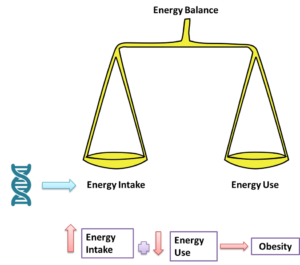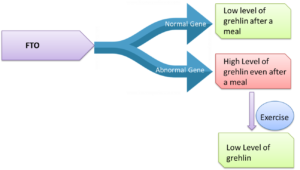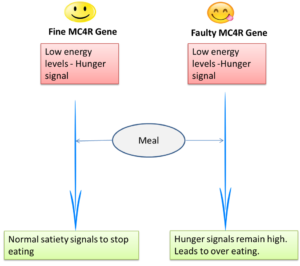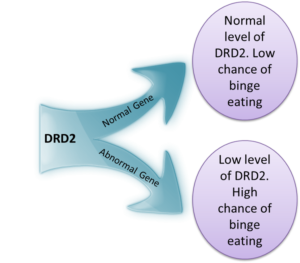Reports
Health
Wellness

A healthy weight is maintained during a state of energy balance- when the energy intake of an individual matches the energy expenditure. Weight can accrue over a long period of time if the intake is higher than expenditure. Besides intake and expenditure, other factors such as age, basal metabolism, hormonal imbalance, and genetics also influence weight gain or weight loss.
Many humans have inherited genetic adaptations, which evolved to mitigate the ancestral exposure to cycles of feast and famine. Hence, the human body is very good at storing excess energy as fat and reluctant to lose valuable stores (fat) of energy. This is the basis of the ‘thrifty gene’ hypothesis, which explains why people easily put on weight on an excess calorie diet and find it very hard to lose it.
The heritability associated with energy intake among children is found to be between 47-69%. Twin studies showed that there was a genetic influence on the type of food consumed, along with satiety and food cue response.
There are many genes that have been shown to be associated with obesity and energy intake. Of particular significance is the FTO gene. Studies have shown that certain variants of this gene were associated with increased energy intake and increased hunger. Individuals with the abnormal FTO gene weigh at least 3kgs more than individuals who have the normal copy of the gene.
Individuals with an abnormal copy of the FTO gene eat more frequently, with a tendency to prefer calorie-dense foods and larger portions of food. People with the highest risk variant should exert portion control and eat a lot of food rich in fiber which would help quell the hunger. They should also consider frequent snacking in small quantities of low calorie, high protein, and high fiber foods to counteract the perpetual hunger they may be experiencing to maintain a stable glycemic index and stable levels of hunger and satiety hormones.

A hormone that plays a key role in satiety is ghrelin. Ghrelin is responsible for ‘hunger pangs’ as it signals the brain to eat. After a meal, the level of ghrelin is lowered and levels of another hormone, Leptin, are elevated resulting in a feeling of fullness. In an individual with the high risk variant of the FTO gene, the level of ghrelin remains high even after a meal, re
sulting in over eating. In such individuals, exercise has been shown to restore the level of ghrelin to normal levels.
Individuals with the abnormal FTO gene should be encouraged to follow a regular exercise pattern which will aid in lowering ghrelin levels and provide better satiety response.

Another important gene that affects meal size and meal choice but not meal frequency is MC4R. When the energy levels drop in our body, the hunger center sends signals that inhibit MC4R and there is an increase in appetite. When the stomach is full after eating, satiety signals are sent by the satiety center that stimulates the MC4R to send signals to stop eating.
Overeating that is induced by distress, emotional eating, leads to binge eating which is highly prevalent in adults who are binge eaters or obese. Binge eating disorder is due to hypersensitivity to reward which results in overeating. The tendency to overeat or binge eat can be determined relatively strongly by analyzing the dopamine D2 receptor gene.
Dopamine is a neurotransmitter and its secretion is increased during emotional upheavals. From an evolutionary aspect, this hormone is released in response to some adverse condition, to prepare the body for a flight or fight response. Under normal circumstances, when dopamine binds to the DRD2 receptor, it should lower feelings of hunger and increase satiety. However, mutations in the DRD2 gene lead to a lower amount of DRD2 in the brain, which could lead to binge eating or overeating.

Individuals who carry the abnormal gene should consciously avoid overeating when feeling distressed or should store healthy snacks to eat at times of distress. Another study showed that deficits in the dopamine D2 receptor led mice to be inactive, which in turn lead to weight gain. Therefore, people with an abnormal gene should consciously stay active.
Regulating energy intake can moderate susceptibility to weight gain and obesity and is essential for people with a higher propensity to gain weight. Interventions that promote self-regulation of energy intake have the potential to control weight gain and also encourage healthy dietary habits. When designing intervention strategies, it is important to understand the genetic aspects involved as nearly 30% of obese individuals underreport their energy intake. The most effective way to fight obesity is through calorie restriction or lowering energy intake. People who carry abnormal genes for energy intake should follow mindful eating to ensure a balance in energy homeostasis.
Individuals who carry the abnormal gene should consciously avoid overeating when feeling distressed or should store healthy snacks to eat at times of distress. Another study showed that deficits in the dopamine D2 receptor led mice to be inactive, which in turn lead to weight gain. Therefore, people with an abnormal gene should consciously stay active.
Regulating energy intake can moderate susceptibility to weight gain and obesity and is essential for people with a higher propensity to gain weight. Interventions that promote self-regulation of energy intake have the potential to control weight gain and also encourage healthy dietary habits. When designing intervention strategies, it is important to understand the genetic aspects involved as nearly 30% of obese individuals underreport their energy intake. The most effective way to fight obesity is through calorie restriction or lowering energy intake. People who carry abnormal genes for energy intake should follow mindful eating to ensure a balance in energy homeostasis.
Find out which variations of these genes you carry and more at www.xcode.life
Nutrigenetics, fitness genetics, health genetics are all nascent but rapidly growing areas within human genetics. The information provided herein is to be read and understood in that context.
Weight loss struggles are an increasing phenomenon world over with the majority of people aspiring to achieve a slim body either for aesthetic reasons or good health. However, in recent years, obesity has increased dramatically in many parts of the world with India ranking third in the world’s most obese countries. According to a study, ‘Global, regional, and national prevalence of overweight and obesity in children and adults during 1980–2013:a systematic analysis for the Global Burden of Disease Study 2013’, India accounts for 15% of the world’s obese population along with China.
With the rise in obesity, there has also been a significant rise in metabolic diseases associated with obesity such as diabetes, hypertension and heart disease. India has been particularly hard hit with rates of diabetes reaching as much as 20% of the population in some parts of the country. Even though accounting for only 20% of the world’s population, India shoulders 60% world heart disease burden. Studies claim that 40% - 70% of obesity is influenced by genetic predisposition, with environmental elements accounting for the rest. As alarming as this is, there is hope for change. Several scientific studies indicate that the prevention of metabolic conditions by lifestyle modifications such as healthy diet and exercise are far more effective than clinical treatment for these conditions at a later stage.
| With over 50% of obesity being attributed to genetics, obesity can be an inherited condition. Studies find that the risk for obesity is 2-8 times higher for a person with a family history as opposed to a person with no family history of obesity. The FTO gene, also commonly known as the obese gene, is considered to be highly contributory to obesity in individuals. People carrying this gene are found to have a 70% higher chance of being obese than non-carriers. Other genes such as MC4R, INSIG, TCF7L2, LEP, IRS, have also been found to contribute to this condition. However, this does not necessitate a certainty of obesity in carriers. Studies have found that corrective lifestyle measures can alleviate obesity even in people with a genetic predisposition. |
Apart from genetics, a variety of environmental factors have also contributed to this rapid increase in obesity. The most prominent of them being unhealthy food choices and decreased physical activity. The increase in access to junk and processed food has led to unhealthy snacking and food habits. Home-cooked meals are maybe visited once a day with the remaining meals consisting of take-outs or packaged food. In addition, a sedentary lifestyle with minimum to nil physical activity greatly adds to the rise of this condition. Another factor for concern is the lack of regular sleep patterns. Working night shifts and staying up late hours in the night have also shown to contribute to an increasing waistline.
Weight management through standard diets or weight loss plan is a key strategy to reduce the risk or more effectively manage metabolic diseases.

However, the vast majority of weight loss solutions either do not work or work temporarily as they are not sustainable over the long term. The global weight loss industry is estimated to be around USD 600 billion. However, a recent 10-year study by King’s College London determined that an overwhelming 99% of people attempting to lose or maintain weight loss will fail in the long run, indicating that the vast majority of the money spent on weight loss treatments is wasted.
A key reason for failure is a one size fits all approach. Diet plans are standardised on a few core ideas such as high protein, high fats or low carbs, and are extended to as many customers as possible to maximise the market reach. Here, it is assumed that everyone’s body is the same on the inside and hence the same recommendations should work for all. This assumption turns out to be misguided. Genetics impacts all aspects of our lives including how we metabolize foods. Some people are capable of eating all they can and are able burn off the calories, while some people struggle to manage their desired weight despite their best attempts. This is because the underlying genetics is different for all individuals. So far, the tools to understand an individual’s genetics were unavailable. However, over the last decade, with significant advancements in science and technology, these tools are now both available and affordable.
Handpicked article for you: Is Dr. Rhonda Patrick Diet For You? Analyze Your DNA Raw Data To Find Out Your Nutritional Needs!

In a recent study by Stanford University, people who followed a diet program tailored to their genetics were shown to lose as much as 2.5 times the amount of weight compared to people who followed a “standard” diet advice. Understanding one’s genetic profile can help individuals understand their body type and tailor their diets to foods best suited to them. A healthcare professional can use insights from the genetic test to then create a personalized diet to help individuals optimize their metabolism, and achieve their weight objectives, while reducing associated health risks.
Weight loss doesn’t just make one look and feel good, but greatly improves the day-to-day quality of life too. Energy levels, mood, temperament, immune system – all get a boost while reducing the risks for several health and metabolic conditions. In fact, healthy lifestyle choices have also found to help control certain conditions like Type 2 diabetes, PCOS and other lifestyle diseases. Not just for the obese or sedentary, proactive individuals should also consider undergoing a genetic test to understand their body’s unique metabolic profile to customise weight management program as per their lifestyle and genetics.
However, it is important to note that genetic testing can guide your effort correctly, but not replace it. Focussing on the overall nature of sustainable weight loss, Dr. M. Lakdawalla of CODS (Centre for Obesity and Digestive Surgery) India, says, “While genes do play some role in causing a predisposition to obesity, I would not say that they are entirely to blame. A paper published by Harvard's TH Chan School of Public Health states that ‘Active adults who carried the obesity-promoting gene had a 30 percent lower risk of obesity than inactive adults who carried the gene’. Worldwide, we have seen an increase in obesity over the past 30 years - it cannot entirely be put down to genetics. There are several factors that play a role - unhealthy lifestyles, rising stress levels, physical inactivity, rise in conditions such as diabetes, etc.”
Genetics is not just about physical differences among individuals. IT influences all aspects of human physiology and impacts several aspects of our health including, how our body responds to fats, carbohydrates, proteins, gluten, lactose, salt, and vitamins. This understanding will continue to grow by leaps and bounds in the years ahead. One thing is for certain, that the era of "standard" diets, nutrition, and medication is over. Evidence from several scientific studies indicates that what we consume as food and medicine need to be tailored to the individual's genetic type.
Increasing nitric oxide (NO) has become the new secret weapon for athletes and bodybuilders. It is used as the primary ingredient in various dietary supplements to support the flow of blood and oxygen to the skeletal muscle and also use them to facilitate the removal of exercise-induced lactic acid buildup which reduces fatigue and recovery time.
Whilst exercise and diet can impact your Nitric Oxide levels, your genes also play a role. Specifically, your NOS3 gene can suggest whether you should be supplementing your diet with Nitric Oxide boosting foods and supplements. Or whether you have a natural advantage in terms of Nitric Oxide levels produced by your body, hence giving you a power based training advantage.
|
[idea]Other factors such as aging, sedentary lifestyle, smoking, high cholesterol, fatty diets, and lack of healthy foods may result in nitric oxide deficiency. Thus, increasing your nitric oxide levels can help increase your energy, vitality and overall wellness.[/idea]
The NOS3 gene produces the Nitric Acid Synthase 3 enzyme, which facilitates the production of nitric oxide (NO). The type of NOS3 gene that you carry influences the production levels of NO. Increased enzyme activity may result in higher production levels of NO. Although the NOS3 gene has been associated with athletic endurance performance and elite power athletic status, research into the NOS3 gene has shown that the one version of this gene has been found at a higher frequency in Polish power based athletes. Studies into Spanish power athletes also showed similar results.
Discover your genes and align your training with your genetic type. Try Xcode’s fitness genetics test which can tell you what versions of the genes are in your DNA.Write to us at info@xcode.in
Diabetes is the most challenging health problem of the 21st century with India being the diabetic capital of the world. More than 65 million Indians are affected from type 2 diabetes and the number is expected to double in the next 20 years. The most shocking news is that 270 million Indians are below the poverty line and yet there is an increase in the diabetic peak. Unlike other health conditions, diabetes does not seem to be inherited in a simple pattern, it is twisted and complicated with a combination of genetic make-up and environmental factors. Yet, most people are born with higher susceptibility to develop type 2 diabetes. According to ADA, the risk of developing type 2 diabetes is:
Type 2 diabetes is mainly caused by an interaction between our genetic makeup and our unhealthy lifestyle choices. Type 2 diabetes is a polygenic disorder where numerous genes have been identified as risk factors. The variation in genes confers some impairment in insulin secretion, utilization, and glucose & lipid homeostasis. If you have type 2 diabetes your body does not use insulin properly. This is called insulin resistance. At first, your pancreas will produce extra insulin to make up for it but, over a period of time, it cannot make enough insulin to keep the blood glucose at normal levels.
The root cause of type 2 diabetes is obesity. It runs down the family as they tend to have a similar lifestyle and eating pattern. Obesity is 80% correlated with diabetes. If you have a family history of obesity it becomes difficult to figure out if your diabetes is mainly caused due to lifestyle factors or genetic variations. It is natural that sedentary parents tend to have sedentary children and their unhealthy eating habits are passed on to the next generation. However, studies have shown that in obese individuals, by losing even 4 kg of the body weight, can reduce the risk of developing type 2 diabetes.
Here are 5 alternative healthy foods to knock out type 2 diabetes:
It’s never too late to start caring for yourself and Xcode provides products and services based on metabolic and fitness genotyping. Even if you carry a genetic risk variant, you can still minimize your risk by understanding your genetics and choosing the right food and lifestyle options that are compatible with your genetic makeup. So take action today to prevent and knock out diabetes.
Our traits are basically divided into genetic and environmental. Genetic factors are the ones a person is born with, and a large chunk of these factors are inherited from the previous generations. Environmental factors include chemical, physical, nutritional, infectious and behavioural factors. Many prevailing diseases such as diabetes and cancer are caused by the complex interplay of genetic and environmental factors. Both the factors will play a part in influencing the diseases. Some may be more influenced by the genetic factors while others will be largely affected by the environmental factors. But, most of the diseases are always associated with the genetic makeup and many inherited diseases can be influenced by environmental conditions.
If you have a genetic predisposition to antisocial behaviour, you may not demonstrate the trait until you experience abuse or neglect in your childhood. If you have had a stress-free and normal childhood, you will never express this specific genetic trait. The expression of a specific trait towards which you are genetically predisposed can be prevented by protective environmental factors. If you have a predisposition to alcohol abuse and live in an alcohol-prohibited environment, it may not express itself. Thus, protective genetic factors have a comparatively less significant effect if environmental exposure is strong.
Response to environmental exposure depends on the genotype, which is a term that defines your genetic make-up for a specific trait/disease. If you have had stress in your early life, it may cause depression in later years. This is only when certain genotypes are present. A person’s genotype can also determine their response to specific medications and their side-effects through various biochemical mechanisms. There is an entire branch of science that studies this called Pharmacogenomics.
If we can identify our genes and characterize their interactions with the environment, we can have intervention strategies to target them. Therefore, when studying the genetic make-up of individuals to determine their natural predisposition towards certain traits and diseases, it is very important to take into consideration the environmental factors like diet, lifestyle, work environment etc, to be able to characterize their inclination towards these traits and their risk for developing specific diseases.
